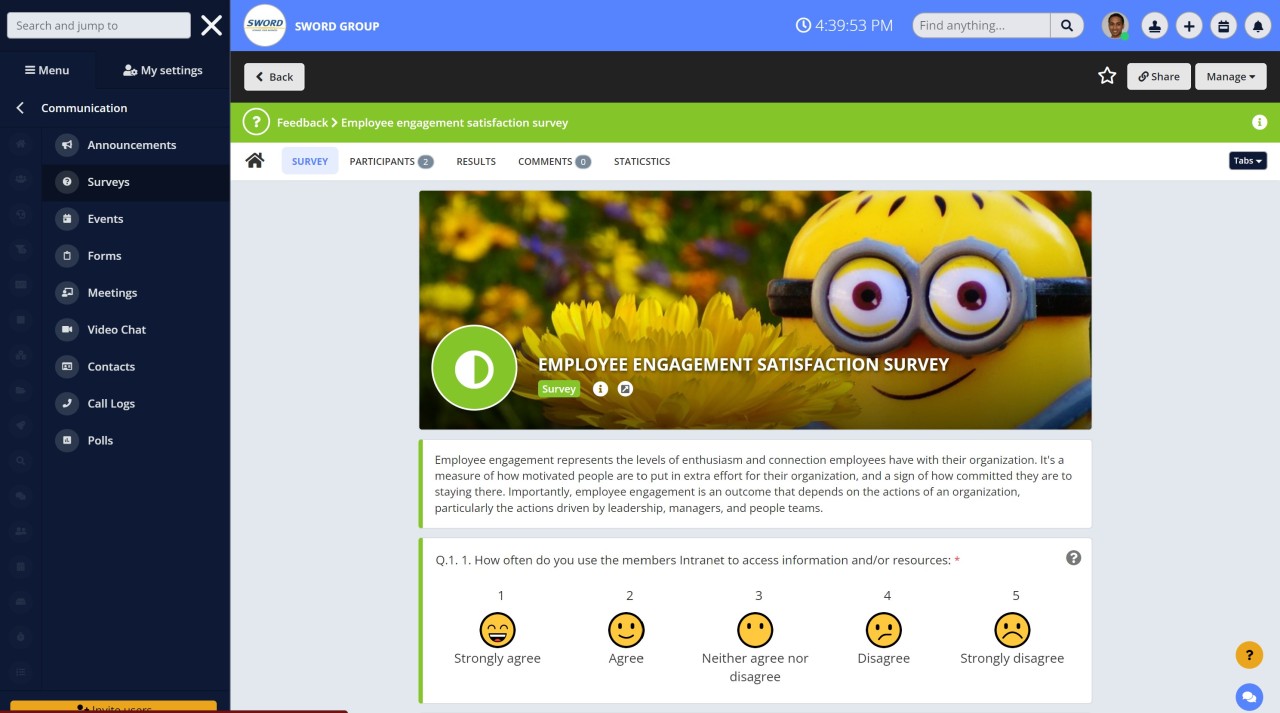Insight Blog
Agility’s perspectives on transforming the employee's experience throughout remote transformation using connected enterprise tools.
5 minutes reading time
(1063 words)
Featured
A Guide to Conducting an Employee Engagement Survey - 4 Steps to a Successful Survey
Here’s some tips for creating an employee engagement survey, the questions you need to ask, and a checklist to get started right away.
In today's competitive job market, employers need to do all they can to find and assess employee engagement. Unfortunately, many companies need to learn how to conduct an engagement survey to provide critical insights that help companies improve their performance.
Employee engagement surveys are important for a variety of reasons. In 2023, it is likely that employee engagement surveys will continue to be important for the following reasons:
- Measuring employee satisfaction and well-being: Engagement surveys provide a way for organizations to assess how satisfied and fulfilled employees are in their work. This can help organizations identify areas where improvements can be made to create a more positive and supportive work environment.
- Identifying areas for improvement: Engagement surveys can help organizations identify specific areas where employees are struggling or where there may be room for improvement. This can include issues related to communication, support, or resources.
- Promoting open communication: Engagement surveys provide a way for employees to give feedback to their employer anonymously. This can help promote open and honest communication, which can be essential for building trust and improving the overall work environment.
- Improving retention and productivity: Engaged employees are more likely to be productive and stay with the organization. By understanding what employees need and value, organizations can work to create a work environment that supports and motivates employees.
Overall, employee engagement surveys are an important tool for organizations to understand and support the needs and well-being of their employees, and to create a positive and productive work environment.
This guide will walk you through the essential steps to ensure a successful survey. So if you're ready to tackle your company's employee engagement challenges head-on, start reading!
Employee engagement 360 survey
An employee engagement 360 survey is a type of survey that collects feedback from multiple sources to assess an employee's level of engagement in the workplace. This type of survey typically involves collecting feedback from the employee's manager, colleagues, and direct reports, as well as the employee themselves.
The purpose of an employee engagement 360 survey is to provide a more comprehensive and well-rounded view of the employee's work experience, including their relationship with their manager and colleagues, their level of job satisfaction, and their overall level of engagement in the organization. This type of survey can be particularly useful for identifying areas of strength and areas for improvement, and for providing targeted feedback and support to employees.
Employee engagement 360 surveys are often conducted online, using a survey platform or software. They typically include a series of questions or statements that employees and other sources are asked to rate or respond to. The results of the survey are then compiled and analyzed to identify trends and patterns, and to provide insights into the employee's overall level of engagement.
Step 1.Researching the right questions to ask
The first step to conducting an employee engagement survey is researching the right questions. The questions in your survey should be tailored to the type of employees you're interested in and their roles.
You'll need to consider how much time each question will take, how many employees you have, and how long it will take for each employee to complete the survey.
Consider whether you can obtain enough responses from your employees to make your survey statistically valid.
Step 2.Pre-assessing data collection methods
Online questionnaires are convenient and easy to complete but limited in capturing all the information needed for effective, long-term employee engagement.
In addition, if you're conducting a large-scale survey, you may need help getting enough responses from your survey participants due to time constraints and other limitations.
Face-to-face interviews are considered the gold standard for gathering complex data about employees and their work environments because they allow for deeper analysis and more open discussion between managers and employees.
However, this type of interview also requires more time than an online questionnaire or survey because it requires someone to be present during the interview.
Step 3.Collecting and analyzing data
Once you've collected the surveys, it's time to analyze the results. This is where the real work begins. The step is to collect all of your survey responses.
While this may seem trivial, it's essential: you need a complete set of answers to determine whether your survey has any problems or whether respondents understood what they were asked.
Once you've collected your responses, it's time to start analyzing them. There are a few things that can be done to make sense of the data from your surveys:
- Create a summary report summarizing key findings from each survey and identifying potential issues with each survey (e.g., low response rate).
- Compare results between groups or across employees within groups (e.g., gender, age).
- Analyze individual responses (e.g., by employee level) for patterns (e.g., high absenteeism by younger employees).
Step 4.Presenting your findings
The final step in conducting an employee engagement survey is to present your findings. This can be done in different ways, but the most effective way is to bring together all the employees who took part in the survey, share your results and discuss how you can use them to improve their work environment.
When presenting your findings, make sure you frame them in a way that will resonate with those who took part. Also, share any data showing certain areas where employees need more training or support. Make sure this information isn't presented as an attack on the company's culture and shows how it can be improved based on what's already been discovered.
Invite those who participated in the survey for another talk or meeting within a few weeks so they can hear more about how their feedback was used and whether any changes were made based on what they said during the initial meeting.
Wrapping up
In this article, we've looked at the different steps involved in conducting an employee engagement survey. We've outlined what needs to be done to ensure that your data is accurate and valuable and provided a few tips on how best to present your findings.
Also, you can use LMS like Bridge Learning to regularly deliver employee engagement surveys. And once you have the data, it's essential to spend time analyzing and learning from it to improve your work environment.
Categories
Blog
(2618)
Business Management
(320)
Employee Engagement
(210)
Digital Transformation
(174)
Growth
(119)
Intranets
(119)
Remote Work
(61)
Sales
(48)
Collaboration
(37)
Culture
(29)
Project management
(29)
Customer Experience
(26)
Knowledge Management
(21)
Leadership
(20)
Comparisons
(6)
News
(1)
Ready to learn more? 👍
One platform to optimize, manage and track all of your teams. Your new digital workplace is a click away. 🚀
Free for 14 days, no credit card required.













